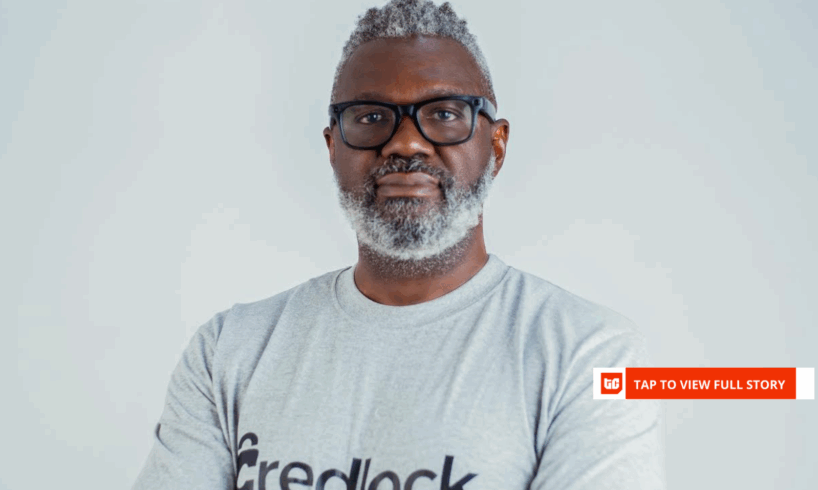
Every year, millions of entrepreneurs and small business owners in Africa’s informal economy are locked out of the formal credit system because they lack traditional collateral and credit history required by banks. This results in an enormous $118 billion credit gap in Nigeria alone, leaving the majority of its over 220 million population reliant on predatory and expensive short-cycle loans.
From the outset, the co-founders of Credlock Africa had a vision to create a trusted and scalable credit infrastructure that makes every essential asset a form of collateral. The Ilorin-based startup, founded in January 2024, focuses on micro lending by turning a smartphone into a guarantee for credit.
Nearly two years later, the company deployed around ₦1.5 billion ($1 million) in credit across 33 of Nigeria’s 36 states. According to Dayo Fabayo, CEO, Credlock Africa, the company has demonstrated capacity for market penetration and execution. Credlock’s approach combines technological innovation in asset security with a debt-financing model that offers cheaper and longer-term credit.
The power of device deterrence
Credlock’s system turns a borrower’s phone into practical collateral through its in-house Android lock tool. It reviews device value, repayment patterns and basic customer information to set lending limits. When a borrower falls behind, the lock restricts the phone while it stays with the user, prompting quick repayments. This deterrent step replaces costly repossessions and is the main reason Credlock claims a recovery rate near 95%.
Read Also: From AI to credit bureaus: How Nigerian digital lenders are tackling rising defaults
Fabayo said the lock is central to the model because most customers settle their dues soon after it triggers, and added that limits, which go up to ₦50,000 ($34), are based on collateral value, repayment history, earlier loan performance, and simple declared data.
The system is built entirely in-house and runs within standard Android security rules, without kernel changes or third-party MDM (mobile device management) tools. This lighter setup works across the wide range of Android devices common in their market and keeps credit costs lower by automating the collateral layer.
“We combine collateral value with behavioral repayment history, previous loan performance and simple customer-declared information to size limits responsibly,” Fabayo added.
Rather than building a repossession business, which is costly and adversarial, Credlock focuses entirely on prevention and deterrence.
“Repossessions are rare and always a last resort. We prioritise restructuring and graduated repayment plans. Our focus is on prevention, not recovery, and the repayment outcomes reflect that, sitting at a low single digit,” Fabayo clarified.
Get The Best African Tech Newsletters In Your Inbox
Credit card
While the device secures the “willingness” to pay, Credlock claims to have built a system to assess the customer’s “ability to pay”. This is done through a “lightweight, privacy respectful framework” that combines collateral value, behavioural repayment history, previous loan performance and customer-declared information to set responsible limits.
This strategy mirrors the secured credit card model of Western markets. Customers start with smaller amounts, borrowing up to 50% of their device value and graduate to higher limits by showing repayment discipline. This approach allows Credlock to manage risk gradually while expanding a customer’s total accessible credit.
Looking forward, this credit line is being extended to a physical product. In the first quarter of 2026, it plans to introduce a card option tied to the FoneFlex line that will create a “secure credit card experience backed by the borrower’s device.” This move leverages the explosive growth in Nigeria’s digital payments (up 17% year over year) and gives the informal sector access to point-of-sale credit, akin to the rapid adoption seen with Moniepoint’s POS systems.
Strategic leverage: debt
In the high-growth, high-volume world of micro credit, the ability to fund the loan book is the primary constraint. Credlock’s deployment of over $1 million is not tied to a single, hefty equity raise, but is debt-backed with a ₦200 million ($137,000) cheque.
“The growth we’ve had so far has been achieved primarily through debt, and our model is intentionally built around responsible leverage and strong repayment performance,” Fabayo said.
Credlock can shift the market away from short-term and predatory loans by using the smartphone as a de-risking mechanism. The security provided by the device collateral enables the company to offer longer tenures of 3 to 6 months cycles to its customers, an advantage over the typical 7-day or one-month cycles.
This longer repayment horizon is healthier for the customer and makes the loan product far more valuable. Scaling this velocity is contingent on Credlock’s capacity to attract institutional debt, which it can do safely because the device collateral infrastructure mitigates risks for the capital provider as well.
Recommended: Unchecked ambition, lax regulations: The genesis of predatory digital lenders in Nigeria
Merchant to customer acquisition
Unlike many fintechs that spend heavily on digital marketing, Credlock embeds its acquisition strategy directly into the existing commerce flow. The majority of their volume comes from merchants, a channel that serves as a low-CAC (customer acquisition cost), high-trust channel.
Merchants are incentivised to originate the line of credit, FoneFlex, because Credlock helps them “sell more devices while removing their financing risk” and manage the complex repayment process. This creates a mutually reinforcing relationship in which merchants achieve higher sales velocity, and Credlock attracts organic customers at the point of need.
According to Fabayo, Credlock knows that the technology alone is not the only edge. “The deterrent feature alone is not the moat. The defensibility comes from our data, trained merchant network, on ground execution, and patent backed solutions,” he said. This combination of proprietary tech and deep operational presence creates a barrier to entry for large players who might attempt to copy a single “lock on default” feature without the surrounding ecosystem.
Credlock is building the credit rails from the ground up
The Credlock team draws from years of hands-on work in mobile commerce. Before launching Credlock, the team built Fairshop, a smartphone resale and trade-in platform, which gave them a close look at device pricing, buyer habits, merchant needs and the credit gap at the last mile.
Working from Ilorin gives them access to strong technical and operational talent, per Fabayo, which, by extension, helps them keep a small team.
Fabayo added that a lean senior group supports the core deterrent system to ensure its security and reliability. The rest of the engineering team handles integrations, partner APIs, data systems and the credit rails for banks, card networks and fintechs. This setup protects the core IP while enabling them to scale partnerships, and also positions Credlock as a key infrastructure layer for Africa’s credit market.





